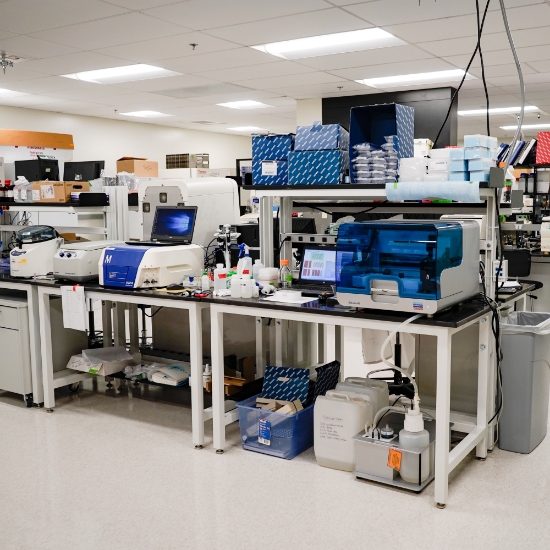Preclinical research is a term that refers to, simply, any research about a drug or treatment for a disease that occurs before it is tested by human volunteers. This encompasses everything from experiments to investigate the causes of the disease to testing potential treatments in animals, and everything in between. Through this process, researchers narrow down the possibilities from a nearly infinite number of potential therapeutic compounds, to one drug candidate for clinical testing.
Why Preclinical Research is Important
It is extremely important that any treatment that reaches human trials be vetted by quality preclinical research. Human clinical trials often require a large amount of time and money. More importantly, however, they also require a great deal of commitment for their participants. Those who volunteer for clinical trials must take on challenges including traveling to trial sites, forgoing other potential treatments, enduring at-times invasive procedures, and facing the possibility of receiving a placebo.
In a 100% fatal and often fast-progressing disease like ALS, participants must also contribute a good deal of their limited time to participate in a trial. Therefore, any drug that makes it to a human trial must have a good reason to be there – strong, well-researched evidence that it has the potential for efficacy in humans. Across all diseases, less than 10% of drugs that enter clinical trials succeed and receive approval. However, good preclinical research should make sure that those that reach human trials have the best chance for success and weed out those that we can determine will not succeed.
Understanding the Four Steps of Preclinical Research
Preclinical research is generally divided into four phases – basic research, drug discovery, lead optimization, and IND-enabling studies. Basic research encompasses any studies conducted by academics, pharmaceutical companies, and others to understand the underlying biology of a disease, and how that disease might be treated. This is often where scientists discover drug targets – the biological pathways they will then attempt to modify with drugs to treat a disease. Next comes the drug discovery phase, in which researchers begin testing drug-like compounds that they believe might affect the drug targets discovered during basic research. These experiments are often conducted by testing hundreds or even thousands of compounds in cellular models of a disease.
The compounds that show promise in these tests are known as “hits.” Hits that show the most promise will be moved into testing in animal models of a disease – most commonly mice, but sometimes others such as fish or fruit flies. These tests take much longer than experiments in cellular models, but, because they occur in living animals rather than individual cells, are usually more representative of how a drug might affect a human.
Drugs that show promise in these tests are called “leads.” As researchers learn more about which leads appear to work well, and which ones appear ineffective and/or harmful, they may chemically modify the compound in question to try to improve its performance. Through this stage of study scientists will also gather information on what doses are the safest and most effective and build a dosing strategy. This third stage of preclinical research is known as “lead optimization,” referring to this process of modifying a compound to arrive at the best possible drug candidate.
Leads with the most promising preclinical data behind them may be advanced to a final round of advanced safety testing called “investigational new drug (IND)-enabling studies.” Federal law in the US requires that any potential treatment submit satisfactory data from a battery of IND-enabling studies to the FDA before the drug’s sponsor can begin conducting human clinical trials. During these studies, drugs are tested in larger animals that more closely mimic human biology.
Sponsors must also submit information about how the drug will be manufactured and outline their plans for the clinical trial they plan to conduct. FDA regulators will then review the results from these IND-enabling studies along with the sponsor’s trial plans. If they conclude that the collective data from the preclinical studies support advancement into a trial, then the clinical trial can move forward.
Preclinical Research at ALS TDI
ALS TDI is the most comprehensive preclinical research institute dedicated solely to ALS. Every day in our lab, ALS TDI scientists conduct basic research, drug discovery, and lead optimization efforts, all under one roof.
Because of its complexity and diversity, we know it will almost certainly take many treatments to end ALS for everyone with ALS. That is why ALS TDI’s mission is to serve as the Drug Discovery Engine for ALS. This means that rather than working to bring a potential treatment we discover through human clinical trials as a traditional biotech company would, we focus exclusively on preclinical research.
Any treatments discovered at ALS TDI are handed off to partners who can oversee them through human trials. This model allows us to focus on feeding the ALS pipeline with promising candidates, rather than dedicating all our resources to a handful of potential treatments. It has resulted in one drug from our lab, tegoprubart, reaching human trials and has supported the advancement of two others, AP101 and Copper ATSM, to human trials through our validation efforts. Two other treatments – Type-1 PRMT Inhibitors and Copper Complexes – are currently in the Drug Discovery and Lead Optimization stages, respectively, while our scientists still continue to search for the next potential treatments to follow these.
We are dedicated to continuing this work to discover new potential treatments for ALS – and sending those drugs to human trials backed by strong preclinical evidence – until there are treatments for everyone living with ALS.
To learn more about ALS TDI’s preclinical research to end ALS, visit https://www.als.net/als-research/.
What to do next: